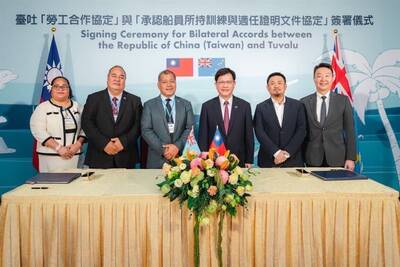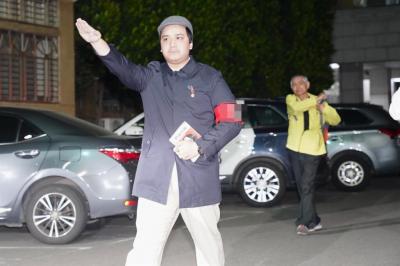As the anniversary of the March 11 magnitude 9.0 earthquake and tsunami that devastated parts of northeastern Japan approaches, some local netizens have organized a campaign on Facebook supporting the residents of Arahama community in Sendai City, Miyagi Prefecture, an area badly hit by the double disaster.
On the page titled “Imploring the Japanese Government to Make Good Use of Taiwanese People’s Love,” the netizens have called on officials to respect the desire of Arahama residents to rebuild their homes in the place many of them have lived for generations.
The Internet campaign came in answer to a call from survivors for help after the Japanese government designated the area around Arahama a “disaster hazard zone” in December last year and ordered all inhabitants to be relocated.
Japanese architect and academic Yasuhiro Ento, who is currently visiting Taiwan, urged Taiwanese, who are no strangers to natural disasters and reconstruction work, to support a campaign by Arahama residents to garner public support for the reconstruction of their community.
Ento, the chief convener of a “yellow handkerchief” campaign for local residents, called for people to write words of support on yellow handkerchiefs and banners, which Japanese earthquake victims regard as symbols of hope, expressing their support for Arahama residents.
Hsia Chu-joe (夏鑄九), a professor at National Taiwan University’s Graduate School of Building and Planning, said Taiwanese donated more than NT$4 billion (US$135 million) last year for Japanese earthquake relief work. It made no sense for Taiwanese to make such generous donations while the Japanese government treated victims so arbitrarily, he said.
“Reconstruction requires the participation of survivors,” he added.
About 170 of the 700 residents of Arahama died in the disaster. Last year, the Japanese government designated the coastal area a “disaster hazard zone” and ordered all residents relocated.
Liao Chia-chan (廖嘉展), chairman of Nantou-based New Homeland Foundation, who has visited the disaster-hit areas of northeastern Japan in person, said that Japan could learn from the experience of Taiwan. For example, the government had relocated disaster-prone villages following the devastation of the magnitude 7.6 921 Earthquake in 1999, and massive flooding and landslides caused by Typhoon Morakot on Aug. 8, 2009.
Liao said that if the people of Arahama were forced to leave the area, where many made a living fishing, they would find it even harder to survive.
One netizen, identified only as Hsu (許), cited examples of Taiwanese forced to relocate after their homes were destroyed, saying that although the relocation provided them with safer places to live, their lives had been “torn from their original culture.” As a result, the devastation wrought by the typhoon had been magnified, he said.
Hsu called on Taiwanese who made donations to the Japanese earthquake victims last year to take a greater interest in whether the victims were being properly looked after.
An exhibition of works by Japanese photographer Junichi Takahashi, which features profiles of people who lost homes, property and family members during the earthquake and tsunami, is currently being held in Taipei.
Takahashi founded “Backup Center Japan” after the earthquake to deliver aid to affected areas. He has since documented the lives of the quake victims through his photography and presented -survivors with albums of photographs as gifts in an effort to help heal their broken hearts.
Behind every photo is a heart-touching story like the one of Chieko Yamane, whose home — which was rebuilt by her parents after a tsunami more than 40 years ago — was badly damaged by the largest earthquake and tsunami ever recorded in Japan.
After deciding to raze the house in which she lived for more than four decades, Yamane wrote on a wall: “Home full of memories. Thank you. Good-bye.”
Despite her sadness at bidding farewell to the old house, she still smiled while telling the photographer that her “love of the sea” had not changed a bit, despite the tsunami that destroyed her home.
See JAPAN’S on Page 9

The Ministry of Economic Affairs has fined Taobao NT$1.2 million (US$36,912) for advertisements that exceed its approved business scope, requiring the Chinese e-commerce platform to make corrections in the first half of this year or its license may be revoked. Lawmakers have called for stricter enforcement of Chinese e-commerce platforms and measures to prevent China from laundering its goods through Taiwan in response to US President Donald Trump’s heavy tariffs on China. The Legislative Yuan’s Finance Committee met today to discuss policies to prevent China from dumping goods in Taiwan, inviting government agencies to report. Democratic Progressive Party Legislator Kuo Kuo-wen (郭國文) said

The Ministry of Economic Affairs has fined Taobao NT$1.2 million (US$36,900) for advertisements that exceeded its approved business scope and ordered the Chinese e-commerce platform to make corrections in the first half of this year or its license would be revoked. Lawmakers have called for stricter supervision of Chinese e-commerce platforms and more stringent measures to prevent China from laundering its goods through Taiwan as US President Donald Trump’s administration cracks down on origin laundering. The legislature’s Finance Committee yesterday met to discuss policies to prevent China from dumping goods in Taiwan, inviting government agencies to report on the matter. Democratic Progressive Party

Taiwan and its Pacific ally Tuvalu on Tuesday signed two accords aimed at facilitating bilateral cooperation on labor affairs, according to Taiwan’s Ministry of Foreign Affairs (MOFA). The governments inked two agreements in Taipei, witnessed by Foreign Minister Lin Chia-lung (林佳龍) and visiting Deputy Tuvaluan Prime Minister Panapasi Nelesone, MOFA said in a news release. According to MOFA, the agreements will facilitate cooperation on labor issues and allow the two sides to mutually recognize seafarers’ certificates and related training. Taiwan would also continue to collaborate with Tuvalu across various fields to promote economic prosperity as well as the well-being of their

Sung Chien-liang (宋建樑), who led efforts to recall Democratic Progressive Party (DPP) Legislator Lee Kun-cheng (李坤城), was released on bail of NT$80,000 today amid outcry over his decision to wear a Nazi armband to questioning the night before. Sung arrived at the New Taipei District Prosecutors’ Office for questioning in a recall petition forgery case last night wearing a red armband bearing a swastika, carrying a copy of Adolf Hitler’s Mein Kampf and giving a Nazi salute. Sung left the building at 1:15am without the armband and covering the book with his coat. Lee said today that this is a serious